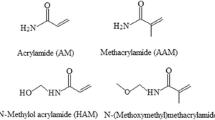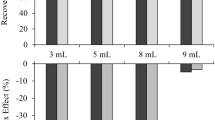Abstract
Acrylamide is a food contaminant that forms through a natural chemical reaction between sugars and asparagine during high-temperature cooking processes. In this work an environmentally friendly and fast routine method for the analysis of acrylamide in Sudanese foods was successfully adapted. The method is based on sample extraction in water, purification with Carrez solutions and detection with high performance liquid chromatography–linear trap quadruple-Orbitrap-mass spectrometry (HPLC LTQ-Orbitrap MS). The performance of two analytical columns namely Kinetex C18 and Rezex ROA-organic acid was compared for acrylamide separation. The method was validated in term of linear range, limit of detection (LOD), limit of quantification (LOQ), precision (RSD%) and recovery. Good linearity (r2 > 0.9988) was achieved using standard addition method in the concentration range 0–200 µg kg− 1. The LOD is in the range from 3.24 to 4.66 µg kg− 1 and 2.47 to 3.94 µg kg− 1 for C18 and ROA columns, respectively. The precision of the method was ≤ 5.65% and 5.73% for C18 and ROA columns, respectively. Recoveries of acrylamide ranging from 86 to 98%, (n = 3) were obtained. It was successfully applied to the analysis of acrylamide in real food samples. Moreover, acrylamide precursors (free asparagine and reducing sugars) were analysed to show the relationship between their concentrations and acrylamide-forming potential.



Similar content being viewed by others
References
O. Kaplan, G. Kaya, C. Ozcan, M. Ince, M. Yaman, Acrylamide concentrations in grilled foodstuffs of Turkish kitchen by high performance liquid chromatography-mass spectrometry. Microchem. J. 93, 173–179 (2009). https://doi.org/10.1016/j.microc.2009.06.006
M. Pan, K. Liu, J. Yang, L. Hong, X. Xie, S. Wang, Review of Research into the determination of Acrylamide in Foods. Foods. 9, 524 (2020). https://doi.org/10.3390/foods9040524
T. Wenzl, de la M. Calle, E. Anklam, Overview on Analytical Methods for the Determination of Acrylamide in food Products. European Commission Joint Research Centre Institute for Reference Materials and Measuremets Food Safety and Unit Retieseweg B-2440 Geel, Belgium. 2003. https://doi.org/10.1080/02652030310001605051
A. Becalski, B.P.-Y. Lau, D. Lewis, S.W. Seaman, W.F. Sun, Determination of acrylamide in various food matrices. Chemistry and Safety of Acrylamide in food. Springer, 2005, 271–284
F. Vezzulli, S. Triachini, A. Mulazzi, M. Lambri, T. Bertuzzi, Acrylamide: impact of precursors concentration, origin, post-harvesting process and roasting level in high quality Arabica and Robusta coffee. Int. J. Food Sci. Technol. (2022). https://doi.org/10.1111/ijfs.15900
N.G. Halford, N. Muttucumaru, S.J. Powers et al., Concentrations of free amino acids and sugars in nine potato varieties: effects of storage and relationship with acrylamide formation. J. Agric. Food Chem. 60, 12044–12055 (2012). https://doi.org/10.1021/jf3037566
V. Yusà, G. Quintas, O. Pardo, P. Martí, A. Pastor, Determination of acrylamide in foods by pressurized fluid extraction and liquid chromatography-tandem mass spectrometry used for a survey of Spanish cereal-based foods. Food Addit. Contam. 23, 237–244 (2006). https://doi.org/10.1080/02652030500415678
N. Muttucumaru, S. Powers, J. Elmore, A. Briddon, D. Mottram, N. Halford, Evidence for the complex relationship between free amino acid and sugar concentrations and acrylamide-forming potential in potato. Ann. Appl. Biol. 164, 286–300 (2014). https://doi.org/10.1111/aab.12101
Z. Ciesarova, E. Kiss, E. Kolek, Study of factors affecting acrylamide levels in model systems. Czech J. food Sci. 24, 133 (2006). https://doi.org/10.17221/3308-CJFS
T.M. Amrein, S. Bachmann, A. Noti et al., Potential of acrylamide formation, sugars, and free asparagine in potatoes: a comparison of cultivars and farming systems. J. Agric. Food Chem. 51, 5556–5560 (2003). https://doi.org/10.1021/jf034344v
M. Gil, P. Ruiz, J. Quijano et al., Effect of temperature on the formation of acrylamide in cocoa beans during drying treatment: an experimental and computational study. Heliyon. 6, e03312 (2020). https://doi.org/10.1016/j.heliyon.2020.e03312
T. Goldmann, A. Perisset, M.-C. Bertholet, R.H. Stadler, E.V. Petersson, K.-E. Hellenäs, Impact of extraction conditions on the content of acrylamide in model systems and food. Food Addit. Contam. 23, 437–445 (2006). https://doi.org/10.1080/02652030600632164
IARC, (1994). Acrylamide. Monographs on the evaluation of carcinogenic risks tohumans: Some industrial chemicals (Vol. 60, pp. 389–433), Lyon, France
M. Negoiță, A.L. Mihai, G.A. Horneț, D.E. Duță, Development of SPE clean-up procedure for acrylamide determination from potato-based products by GC-MS/MS. Open Agric. 5, 305–316 (2020). https://doi.org/10.1515/opag-2020-0039
M.M.A. Omar, W.A.W. Ibrahim, A.A. Elbashir, Sol–gel hybrid methyltrimethoxysilane–tetraethoxysilane as a new dispersive solid-phase extraction material for acrylamide determination in food with direct gas chromatography–mass spectrometry analysis. Food Chem. 158, 302–309 (2014). https://doi.org/10.1016/j.foodchem.2014.02.045
E. Tareke, P. Rydberg, P. Karlsson, S. Eriksson, M. Törnqvist, Analysis of acrylamide, a carcinogen formed in heated foodstuffs. J. Agric. Food Chem. 50, 4998–5006 (2002). https://doi.org/10.1021/jf020302f
S. Zeng, W. Chen, J. Ye, C. Yang, Investigation on the Contents of Acrylamide in Baked and Fried foods. IOP Conference Series: Earth and Environmental Science. IOP Publishing, 2020, p. 012058. https://doi.org/10.1088/1755-1315/512/1/012058
L. González-Gómez, S. Morante-Zarcero, D. Pérez-Quintanilla, I. Sierra, Simultaneous determination of furanic compounds and acrylamide in insect-based foods by hplc-qqq-ms/ms employing a functionalized mesostructured silica as sorbent in solid-phase extraction. Foods. 10, 1557 (2021). https://doi.org/10.3390/foods10071557
M.M.A. Omar, A.A. Elbashir, O.J. Schmitz, Determination of acrylamide in Sudanese food by high performance liquid chromatography coupled with LTQ orbitrap mass spectrometry. Food Chem. 176, 342–349 (2015). https://doi.org/10.1016/j.foodchem.2014.12.091
S. Eslamizad, F. Kobarfard, K. Tabib, H. Yazdanpanah, J. Salamzadeh, Development of a sensitive and rapid method for determination of acrylamide in bread by LC-MS/MS and analysis of real samples in Iran IR. Iran. J. Pharm. Research: IJPR. 19, 413 (2020). https://doi.org/10.22037/ijpr.2019.111994.13474
P. Panja, Green extraction methods of food polyphenols from vegetable materials. Curr. Opin. Food Sci. 23, 173–182 (2018). https://doi.org/10.1016/j.cofs.2017.11.012
K. Granby, Guidance document on analyses of acrylamide in food including analyses in the low concentration range. 2019
T. Culhaoglu, D. Zheng, V. Méchin, S. Baumberger, Adaptation of the Carrez procedure for the purification of ferulic and p-coumaric acids released from lignocellulosic biomass prior to LC/MS analysis. J. Chromatogr. B 879, 3017–3022 (2011). https://doi.org/10.1016/j.jchromb.2011.08.039
A.D. Troise, A. Fiore, V. Fogliano, Quantitation of acrylamide in foods by high-resolution mass spectrometry. Journal of agricultural and food chemistry. 2014; 62: 74 – 9. https://doi.org/10.1021/jf404205b J. Agric. Food Chem. 2014, 62, 74 – 79
M.M.A. Omar, A.A. Elbashir, O.J. Schmitz, Capillary electrophoresis method with UV-detection for analysis of free amino acids concentrations in food. Food Chem. 214, 300–307 (2017). https://doi.org/10.1016/j.foodchem.2016.07.060
T. Delatour, A. Périsset, T. Goldmann, S. Riediker, R.H. Stadler, Improved sample preparation to determine acrylamide in difficult matrixes such as chocolate powder, cocoa, and coffee by liquid chromatography tandem mass spectroscopy. J. Agric. Food Chem. 52, 4625–4631 (2004). https://doi.org/10.1021/jf0498362
I. Gielecinska, H. Mojska, Optimisation and validation of the analytical procedure for the determination of acrylamide in coffee by LC-MS/MS with SPE clean up. Roczniki Państwowego Zakładu Higieny 2013; 64
C.-L. Ky, M. Noirot, S. Hamon, Comparison of five purification methods for chlorogenic acids in green coffee beans (Coffea Sp). J. Agric. Food Chem. 45, 786–790 (1997)
H.Z. Şenyuva, V. Gökmen, Study of acrylamide in coffee using an improved liquid chromatography mass spectrometry method: investigation of colour changes and acrylamide formation in coffee during roasting. Food Addit. Contam. 22, 214–220 (2005). https://doi.org/10.1080/02652030500109834
G.-A. Bent, P. Maragh, T. Dasgupta, Acrylamide in Caribbean foods–residual levels and their relation to reducing sugar and asparagine content. Food Chem. 133, 451–457 (2012). https://doi.org/10.1016/j.foodchem.2012.01.067
N. Surdyk, J. Rosén, R. Andersson, P. Åman, Effects of asparagine, fructose, and baking conditions on acrylamide content in yeast-leavened wheat bread. J. Agric. Food Chem. 52, 2047–2051 (2004). https://doi.org/10.1021/jf034999w
V. Forstova, B. Belkova, K. Riddellova, L. Vaclavik, J. Prihoda, J. Hajslova, Acrylamide formation in traditional Czech leavened wheat-rye breads and wheat rolls. Food Control. 38, 221–226 (2014). https://doi.org/10.1016/j.foodcont.2013.10.022
A. Mustafa, M. Fink, A. Kamal-Eldin, J. Rosén, R. Andersson, P. Åman, Interaction effects of fermentation time and added asparagine and glycine on acrylamide content in yeast-leavened bread. Food Chem. 112, 767–774 (2009). https://doi.org/10.1016/j.foodchem.2008.05.099
S. Ou, J. Shi, C. Huang et al., Effect of antioxidants on elimination and formation of acrylamide in model reaction systems. J. Hazard. Mater. 182, 863–868 (2010). https://doi.org/10.1016/j.jhazmat.2010.06.124
J. Bassama, P. Brat, P. Bohuon, R. Boulanger, Z. Günata, Study of acrylamide mitigation in model system: Effect of pure phenolic compounds. Food Chem. 123, 558–562 (2010). https://doi.org/10.1016/j.foodchem.2010.04.071
Acknowledgements
The authors are thankful to the Deanship of Scientific Research and under the supervision of the Scientific and Engineering Research Centre at Najran University for funding this work under the Research centers Funding program grant code (NU/RCP/SERC/12/1).
Author information
Authors and Affiliations
Corresponding author
Ethics declarations
Conflict of interest
The authors declare no conflict of interest.
Additional information
Publisher’s Note
Springer Nature remains neutral with regard to jurisdictional claims in published maps and institutional affiliations.
Rights and permissions
Springer Nature or its licensor (e.g. a society or other partner) holds exclusive rights to this article under a publishing agreement with the author(s) or other rightsholder(s); author self-archiving of the accepted manuscript version of this article is solely governed by the terms of such publishing agreement and applicable law.
About this article
Cite this article
Omar, M.M.A., Elbashir, A.A., Schmitz, O.J. et al. Validation of high-performance liquid chromatography coupled with LTQ orbitrap mass spectrometry for analysis of acrylamide. Food Measure 18, 930–939 (2024). https://doi.org/10.1007/s11694-023-02223-w
Received:
Accepted:
Published:
Issue Date:
DOI: https://doi.org/10.1007/s11694-023-02223-w




